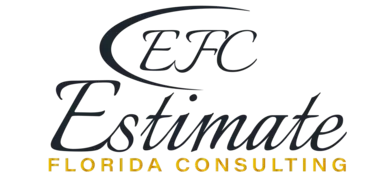Cost Breakdown For Drywall Installation Estimate
When planning a construction project, it’s vital to understand the breakdown of costs to ensure a comprehensive budget. Material costs, which include the necessary supplies and resources for the project, can range from $1,625 to $4,063, depending on the quality and quantity required. Labor costs, which account for the skilled workforce needed to execute the project, can vary significantly from $3,510 to $10,920, reflecting the expertise and time commitment involved. Additional costs, which may encompass expenses such as equipment rental, site preparation, or unforeseen challenges, typically add between $520 and $1,170 to the overall budget.
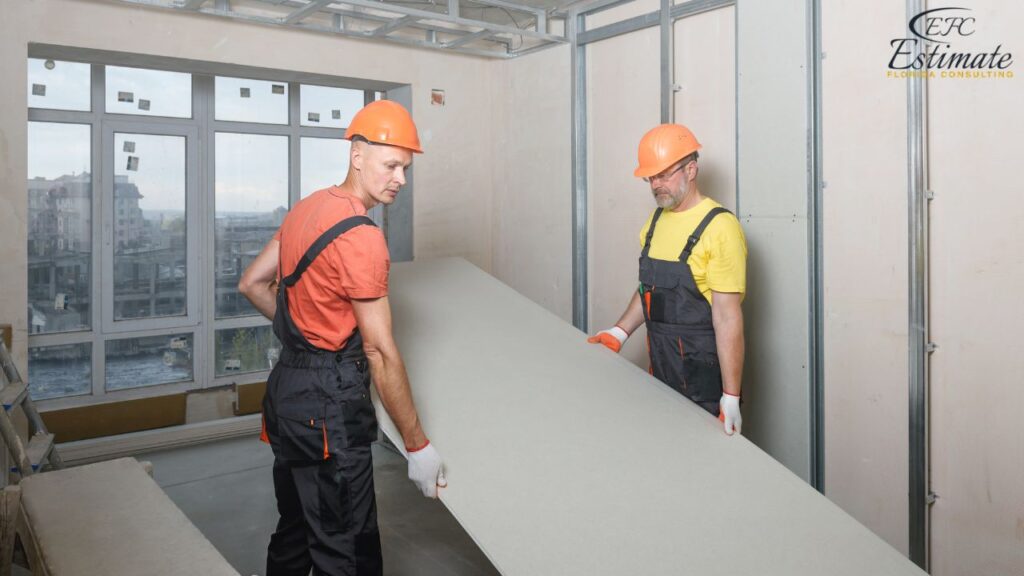
Consequently, the total estimated cost for the project can range from $5,655 to $16,153, highlighting the importance of detailed planning and cost management.
What is Drywall?
Drywall, also known as plasterboard or sheetrock, is a popular building material made of gypsum sandwiched between paper or fiberglass mats. It’s commonly used for constructing interior walls and ceilings in homes and commercial buildings due to its ease of installation, cost-effectiveness, and versatility. Standard drywall panels are usually 4 feet wide and 8 to 12 feet long, attached to studs with screws or nails, and finished with joint tape and compound for a seamless look. Drywall offers a smooth, paintable surface and comes in specialized types, such as moisture-resistant, soundproof, and fire-rated, making it suitable for various applications and environments.
Key Factors Influencing Drywall Installation Costs
Project Size and Scope
The size and scope of the project are primary determinants of drywall installation costs. Larger projects require more materials and labor, increasing the overall budget. The complexity of the layout, such as curved walls, vaulted ceilings, or intricate designs, can also impact costs due to the additional time and skill required for installation. When planning your project, consider the total square footage of the areas to be drywalled, including any additional rooms, hallways, or unique architectural features. Having a clear understanding of the project scope will help you communicate your needs to drywall contractors and obtain accurate estimates. Additionally, larger projects may benefit from bulk purchasing discounts on materials, potentially offsetting some costs.
Cost Breakdown: Project Size
Project Size (Sq Ft) | Estimated Cost (Standard Drywall) |
500 | $2,113 – $2,813 |
1,000 | $4,225 – $5,625 |
2,000 | $8,450 – $11,250 |
Type and Quality of Drywall
Different types of drywall are available, each with varying costs based on quality and purpose. Standard drywall is the most economical, while moisture-resistant or fire-resistant drywall may cost more but provide additional benefits. Moisture-resistant drywall, often referred to as green board, is ideal for areas prone to humidity, such as bathrooms and kitchens. Fire-resistant drywall, or Type X, offers enhanced safety features for spaces requiring extra protection, like garages and utility rooms. Choosing the right type of drywall for specific areas is crucial for durability and performance, ensuring your investment stands the test of time. Furthermore, specialized drywall options, such as soundproof or mold-resistant drywall, are available for specific needs, offering tailored solutions that enhance the functionality and comfort of your home.
Cost Breakdown: Drywall Type
Drywall Type | Estimated Cost per Sheet (4×8 ft) | Total Cost (for 1,000 Sq Ft) |
Standard Drywall (1/2″) | $13 – $20 | $1,625 – $2,438 |
Moisture-Resistant | $20 – $26 | $2,438 – $3,250 |
Fire-Resistant | $26 – $33 | $3,250 – $4,063 |
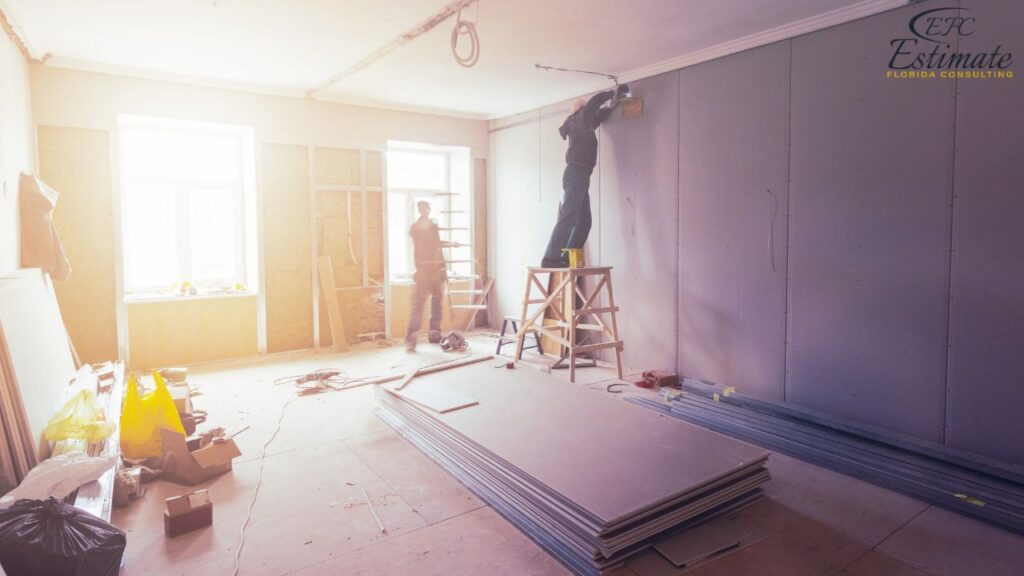
Labor Costs
Labor costs can vary significantly based on the region, the experience of the installers, and the complexity of the job. Hiring skilled professionals ensures quality workmanship and adherence to timelines, reducing the risk of costly repairs or delays. Experienced drywall contractors can handle challenging installations, such as high ceilings or angled walls, with precision and efficiency. They also have the expertise to troubleshoot potential issues that may arise during drywall installation, providing peace of mind and ensuring a smooth, seamless finish. When selecting a contractor, request multiple quotes and verify their credentials to make an informed decision. Skilled labor not only impacts the quality of the finish but also the efficiency of the installation process, ensuring that the project is completed on time and within budget.
Cost Breakdown: Labor
Task | Estimated Hours | Cost per Hour | Total Cost Estimate (for 1,000 Sq Ft) |
Drywall Hanging | 40 – 60 | $39 – $78 | $1,560 – $4,680 |
Taping and Mudding | 30 – 50 | $39 – $78 | $1,170 – $3,900 |
Sanding and Finishing | 20 – 30 | $39 – $78 | $780 – $2,340 |
Finishing and Additional Services
The level of finish required for the drywall can influence costs. A smooth, high-quality finish suitable for painting or wallpapering may require additional coats of joint compound and sanding, increasing labor and material costs. The drywall finishing process is typically categorized into five levels, with Level 0 indicating no finish and Level 5 offering the highest quality, often used for high-gloss or specialty finishes. Additional services like soundproofing, insulation, or special texture finishes can also add to the overall expense. When planning your project, consider your desired finish level and any additional enhancements to achieve the perfect look and functionality.
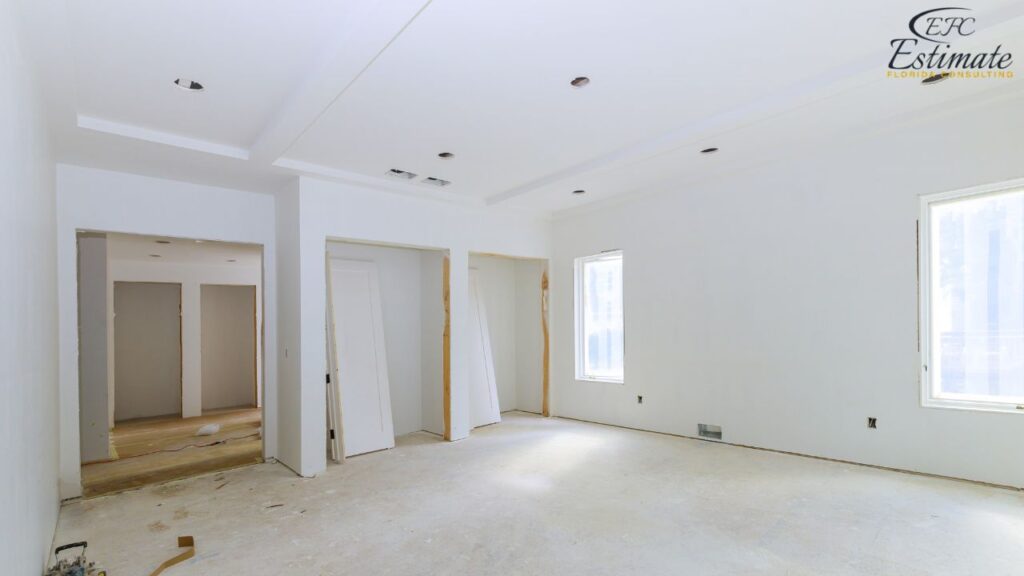
Custom finishes, such as knockdown or orange peel textures, can add unique character to your space, offering aesthetic appeal while masking minor imperfections.
Cost Breakdown: Finishing Level
Finish Level | Description | Estimated Additional Cost (per Sq Ft) |
Level 0 | No finish (unfinished) | $0 |
Level 1 | Basic taping | $0.30 – $0.50 |
Level 2 | Taping with compound | $0.50 – $0.70 |
Level 3 | Additional compound coats | $0.70 – $0.90 |
Level 4 | Ready for flat paint | $0.90 – $1.20 |
Level 5 | Smoothest, for high gloss/lighting | $1.20 – $1.50 |
Understanding Drywall Installation
Purpose and Benefits of Drywall
Drywall is a versatile building material used to create interior walls and ceilings. It offers several advantages, including fire resistance, sound insulation, and ease of installation. Drywall provides a smooth, clean surface that can be painted or wallpapered to suit any design aesthetic. Its lightweight nature makes it easy to work with, allowing for quick installation and repairs. With complete guide to drywall installation you must get adorable finishes.
Different Types of Drywall
There are various types of drywall available, each designed to meet specific needs. Understanding the different types can help you choose the right one for your project:
- Standard Drywall: This is the most common type used in interior construction. It’s affordable and suitable for most rooms.
- Moisture-Resistant Drywall (Green Board): Ideal for areas with high humidity, such as bathrooms and kitchens, as it helps prevent mold growth.
- Fire-Resistant Drywall (Type X): Used in areas requiring extra fire protection, such as garages or utility rooms.
- Soundproof Drywall: Designed to reduce noise transmission between rooms, making it ideal for home theaters or bedrooms.
Get Acquainted with Drywall Installation
Drywall Installation by Project Type
Residential Drywall Installation
Residential drywall installation is a common component of home construction and renovation, often characterized by relatively straightforward processes and standard materials. In most standard residential projects, costs tend to be lower due to simpler layouts, standard room sizes, and conventional ceiling heights, typically ranging from 8 to 10 feet. These factors make the installation process more efficient, reducing the need for specialized tools or techniques. However, costs can significantly increase in custom homes, where unique architectural features come into play. Homes with higher or vaulted ceilings, intricate designs such as tray or coffered ceilings, and custom wall features like arches or recessed niches require additional labor, specialized skills, and sometimes even custom materials.
Commercial Drywall Installation
Commercial drywall installation typically presents a different set of challenges compared to residential projects, often involving larger, more complex spaces such as office buildings, retail stores, hospitals, or industrial facilities. One of the primary factors contributing to higher costs in commercial drywall projects is the need to accommodate larger areas and higher ceilings, which are common in commercial architecture. These environments often require specialized equipment, such as scaffolding or lifts, and additional labor to manage the physical demands of installing drywall at greater heights. Moreover, commercial buildings frequently have specific requirements related to fire resistance and soundproofing, particularly in spaces like offices, hotels, or mixed-use developments. These requirements necessitate the use of fire-rated or acoustic drywall, which is more expensive than standard drywall and requires precise installation to meet building codes and regulations.
Remodeling and Renovation
Drywall installation in remodeling and renovation projects can present a unique set of challenges that often result in higher costs compared to new construction. One of the primary difficulties lies in matching new drywall to existing structures, especially in older buildings where the original walls may be uneven, damaged, or constructed with materials no longer in use. This can require additional prep work, such as removing old wall coverings, repairing damaged framing, or applying extra layers of joint compound to achieve a smooth transition between old and new surfaces. Irregular framing is another common issue in renovations, as older homes may not have perfectly level walls or standard stud spacing, necessitating adjustments during installation. The scope of renovation projects can also vary widely, from small-scale updates in single rooms to extensive overhauls involving multiple spaces, each with its own set of challenges.
Planning Your Drywall Project
Assessing Project Requirements
Before beginning your drywall installation project, it’s important to assess the specific requirements of your space. Consider factors such as the square footage of the area, the layout of the rooms, and any unique architectural features. This assessment will help you determine the quantity and type of drywall needed, as well as any additional materials or services required.
Setting a Realistic Budget
Establishing a realistic budget is crucial for a successful drywall installation project. Start by calculating the costs of materials, labor, and additional services based on your project’s scope and specifications. Be sure to include a contingency fund to cover unexpected expenses or changes to the project scope. A well-planned budget will help you make informed decisions and ensure that your project stays on track financially.
Common Challenges in Drywall Installation
Dealing with Moisture and Mold
One of the most persistent challenges in drywall installation is dealing with moisture intrusion, which can lead to significant issues such as mold growth and structural damage. Moisture is particularly problematic in areas like basements, bathrooms, kitchens, and other spaces that are prone to high humidity or direct water exposure. When drywall absorbs moisture, it can weaken and deteriorate, creating an ideal environment for mold spores to thrive. Mold not only compromises the integrity of the drywall but also poses serious health risks to occupants, including respiratory problems and allergic reactions. To mitigate these risks, it is essential to use moisture-resistant drywall, often referred to as green board or cement board, specifically designed to withstand damp conditions.
Addressing Cracks and Settlement
Cracks in drywall are a common issue, often caused by the natural settling of a building over time or by fluctuations in temperature and humidity that cause expansion and contraction of the structure. Settlement cracks typically appear at the seams between drywall sheets, around door and window frames, or in corners where different materials meet. These cracks can be unsightly and, if left unaddressed, may lead to more extensive damage. To minimize the occurrence of cracks, it is essential to employ proper installation techniques from the beginning. Using mesh tape instead of paper tape can provide added strength and flexibility, helping to accommodate minor shifts in the building’s structure. High-quality joint compounds, often referred to as mud, are also critical in this process; lightweight or setting-type compounds offer better crack resistance than standard all-purpose types.
Soundproofing Requirements
Soundproofing is a crucial consideration in drywall installation, particularly in environments where noise reduction is important, such as in multi-family buildings, offices, home theaters, or recording studios. The standard drywall does little to block sound transmission, which can lead to disturbances and a lack of privacy. To address this, soundproof drywall, also known as acoustic drywall, is used, which is designed with enhanced density and specialized cores that help to dampen sound vibrations. In addition to using soundproof drywall, additional methods to improve soundproofing include installing resilient channels, which are metal strips that create a gap between the drywall and the framing, thus reducing sound transfer. Adding insulation, such as mineral wool or fiberglass batts, within the wall cavities also significantly enhances sound absorption.
Choosing the Right Contractor
Evaluating Experience and Expertise
Choosing the right drywall contractor is crucial for a successful installation. Look for contractors with a proven track record of high-quality work and positive customer reviews. Verify their licensing and insurance to ensure they meet industry standards and can handle any potential issues. Experienced contractors can offer valuable insights into your project, recommending the best materials and finishes to meet your needs. They can also provide solutions to common challenges, such as uneven surfaces or structural obstacles, ensuring a smooth and seamless finish. A well-qualified contractor will be able to offer advice on the best practices for your specific project, helping to maximize the efficiency and quality of the installation.
Requesting Detailed Quotes
When gathering estimates, request detailed quotes that break down the costs of materials, labor, and any additional services. This transparency helps you compare different contractors and understand the value they offer. A comprehensive quote should include all aspects of the project, from initial preparation to final finishing touches. Ensure that the quote covers potential contingencies, such as additional labor for unexpected issues or adjustments to the project scope. By obtaining multiple quotes, you can make an informed decision that aligns with your budget and quality expectations.
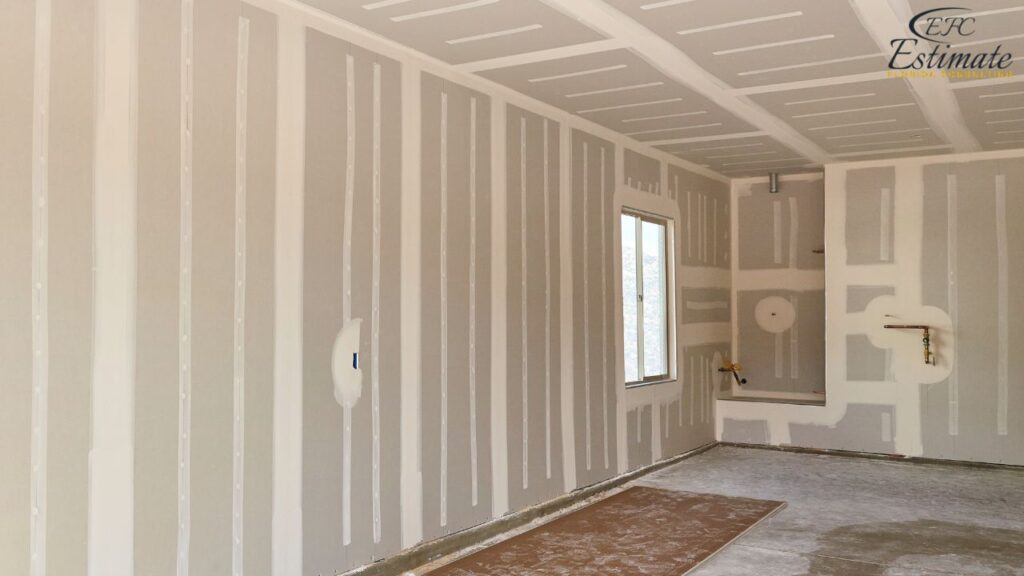
Additional Considerations
Quality of Finish
The quality of the drywall finish can significantly impact the overall cost. A Level 4 or 5 finish, which is suitable for smooth walls ready for high-gloss paint, requires more labor and materials compared to a Level 1 or 2 finish, which may be sufficient for areas not exposed to close scrutiny. Discuss your finish preferences with your contractor to align expectations and budget accordingly. Higher-level finishes are ideal for accent walls or feature areas, where the aesthetic quality is paramount. Investing in a higher-quality finish can enhance the visual appeal and resale value of your home, making it a worthwhile consideration.
Environmental Considerations
Consider using eco-friendly drywall options or recycling leftover materials to reduce environmental impact. Some drywall products are made from recycled content or are designed to improve indoor air quality, which can be a selling point for environmentally conscious homeowners. Sustainable building practices not only benefit the environment but can also enhance the health and comfort of your home. Look for certifications such as GREENGUARD or LEED, which indicate adherence to sustainable manufacturing and building practices. Choosing eco-friendly options can also contribute to long-term savings on energy bills and maintenance costs.
Download Template For Drywall Project Breakdown
- Materials list updated to the zip code
- Fast delivery
- Data base of general contractors and sub-contractors
- Local estimators
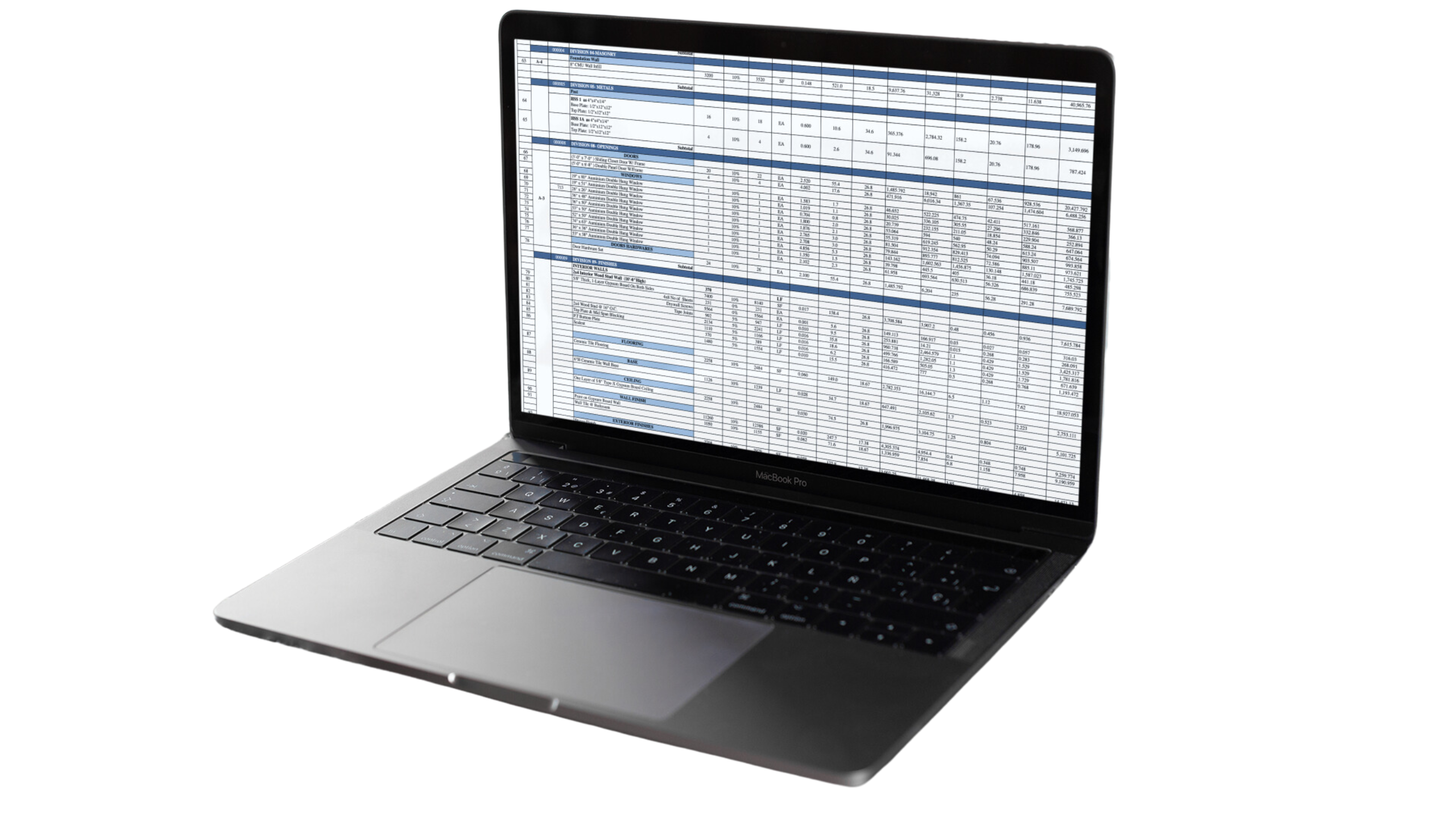
Unexpected Challenges
During installation, unforeseen issues such as structural irregularities, existing damage, or moisture problems can arise, potentially increasing costs. It’s wise to budget an extra 10-15% to cover these unexpected challenges. Preparing for these contingencies ensures that your project can proceed smoothly without compromising quality or timelines. Regular communication with your contractor and proactive problem-solving can help mitigate the impact of unexpected challenges. By anticipating potential obstacles, you can avoid costly delays and ensure that your project stays on track.
DIY vs. Professional Installation
While some homeowners may consider DIY drywall installation to save money, professional installation is recommended for achieving a high-quality finish. Experienced installers have the skills and tools needed to handle complex layouts and ensure a seamless result, reducing the risk of costly mistakes. DIY projects can often lead to uneven surfaces and visible seams, detracting from the overall appearance and requiring costly corrections. Professional installation guarantees a polished, professional look that adds value to your home. By investing in professional services, you can ensure that your drywall installation meets the highest standards of quality and durability.
Tips for Reducing Drywall Installation Costs
Buy Materials in Bulk
One effective strategy for reducing drywall installation costs is purchasing materials in bulk, which can lead to substantial savings, especially on larger projects. Buying in bulk allows you to take advantage of volume discounts that are often offered by suppliers or manufacturers, making it a cost-effective option for both materials like drywall sheets, joint compounds, screws, and other related supplies. Working closely with your contractor to accurately assess the required quantities is crucial, as overbuying can lead to unnecessary expenses, while underestimating can result in multiple orders and increased costs due to delivery fees.
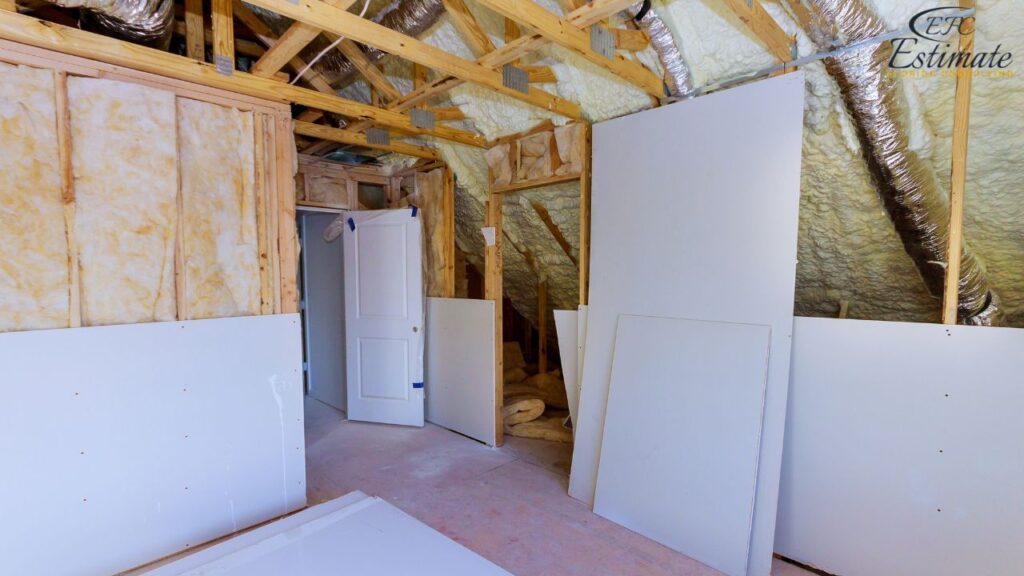
Simplify the Design
Simplifying the design of your project is another practical way to reduce drywall installation costs, as complex layouts and architectural features can significantly drive up both material and labor expenses. Intricate elements such as arches, niches, recessed areas, or elaborate ceiling designs require more precise cutting, fitting, and finishing, all of which add time and effort to the installation process. By opting for straightforward, functional room layouts and standard ceiling heights, you can streamline the installation, making it more efficient and less labor-intensive. Simplifying the design doesn’t mean sacrificing aesthetics; it simply involves making smart choices that prioritize budget-friendly options while still achieving a visually pleasing result. For example, choosing standard square or rectangular spaces over those with curved walls or multiple angles can help to reduce the amount of material waste, as drywall sheets can be used more efficiently without the need for excessive cutting and trimming.
Do Some Prep Work Yourself
Taking on some of the prep work yourself can be a practical way to cut down on overall drywall installation costs, especially for those who are comfortable with basic DIY tasks. Preparation tasks such as clearing the work area, removing furniture, and protecting floors and fixtures from dust and debris can be handled by homeowners or building occupants, saving valuable time for the professional installers who can then focus solely on the core installation tasks. Another area where you can contribute is by removing old drywall if you’re undertaking a renovation; this task, while labor-intensive, doesn’t require specialized skills and can significantly lower labor costs if you’re willing to put in the effort.
Schedule During Off-Peak Times
Scheduling your drywall installation during off-peak times can be an effective strategy to reduce labor costs, as many contractors offer lower rates when demand is lower. Off-peak periods often include times outside of the busy summer construction season or avoiding holidays when contractors are typically fully booked. By planning your project during slower periods, you can take advantage of contractors looking to fill gaps in their schedules, which can sometimes lead to more competitive pricing.
Get 5 New Leads Next 7 Days With Our System
- Multi-Family House
- Single-Faimly House
- Modern House
- Duplex
- Ranch House
- Bungalow
Conclusion
An accurate cost breakdown for drywall installation involves considering materials, labor, and additional expenses. By understanding these components and working with skilled professionals, homeowners can ensure that their project is completed on time, within budget, and to the desired level of quality. Careful planning and budgeting will help prevent unexpected costs and ensure a successful installation that enhances the home’s appearance and functionality. Whether you’re renovating a single room or building a new home, investing in high-quality drywall installation sets the stage for a beautiful and durable interior. By taking the time to plan and prepare, you can create a space that meets your needs and reflects your personal style.
FAQs
A drywall installation estimate typically includes costs for materials, labor, and additional expenses such as equipment rental or site preparation. The total estimated cost for the project can range from $5,655 to $16,153, depending on the size, scope, and complexity of the work involved.
The size and scope of the project are primary determinants of costs. Larger projects require more materials and labor, increasing the overall budget. Complex layouts, such as curved walls or vaulted ceilings, can also impact costs due to the additional time and skill required for installation.
Here is the estimated cost breakdown for drywall installation based on project size:
- 500 Sq Ft: $2,113 – $2,813
- 1,000 Sq Ft: $4,225 – $5,625
- 2,000 Sq Ft: $8,450 – $11,250
Different types of drywall vary in cost based on quality and purpose. Standard drywall is the most economical, while moisture-resistant or fire-resistant drywall may cost more but provide additional benefits. Choosing the right type of drywall for specific areas is crucial for durability and performance.
Here is the estimated cost breakdown for different types of drywall:
- Standard Drywall (1/2″): $1,625 – $2,438
- Moisture-Resistant: $2,438 – $3,250
- Fire-Resistant: $3,250 – $4,063
Labor costs vary based on the region, the experience of the installers, and the complexity of the job. Hiring skilled professionals ensures quality workmanship and adherence to timelines, reducing the risk of costly repairs or delays.
Here is the estimated labor cost breakdown for common drywall tasks:
- Drywall Hanging: 40 – 60 hours, $39 – $78 per hour, Total: $1,560 – $4,680
- Taping and Mudding: 30 – 50 hours, $39 – $78 per hour, Total: $1,170 – $3,900
- Sanding and Finishing: 20 – 30 hours, $39 – $78 per hour, Total: $780 – $2,340
Google Reviews

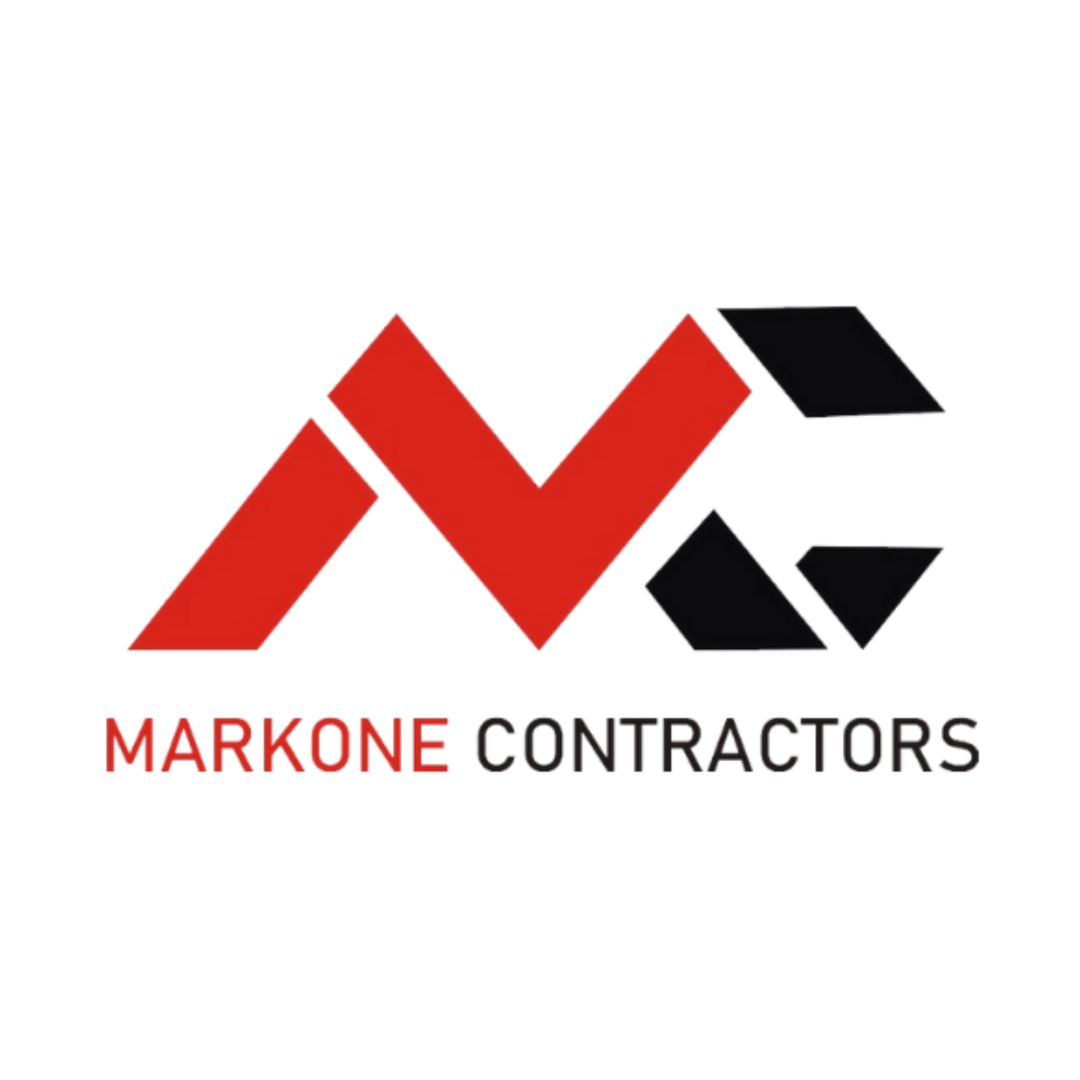
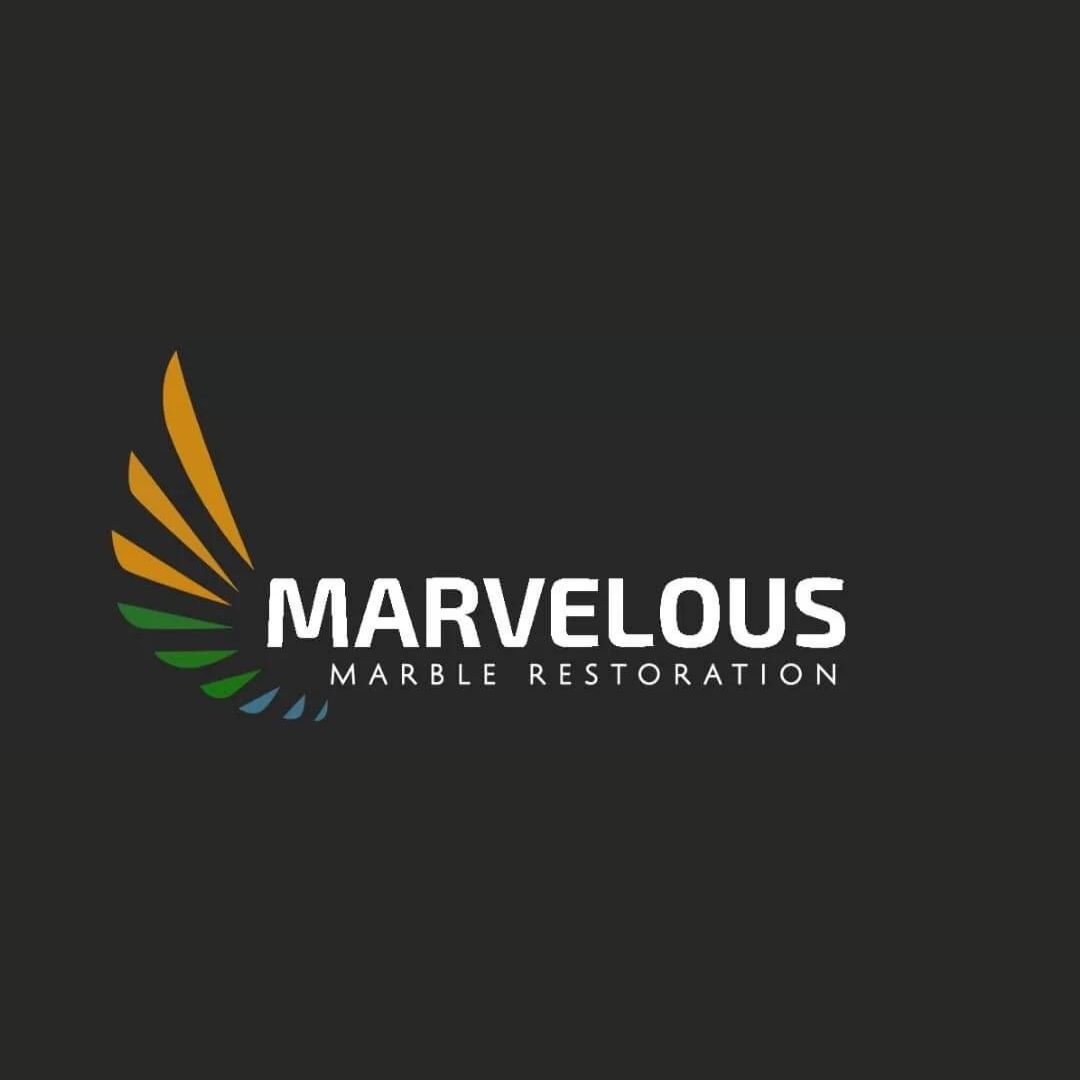
Process To Get The Drywall Cost Estimate Report
Here I am going to share some steps to get the drywall cost estimate report.
-
You need to send your plan to us.
You can send us your plan on info@estimatorflorida.com
-
You receive a quote for your project.
Before starting your project, we send you a quote for your service. That quote will have detailed information about your project. Here you will get information about the size, difficulty, complexity and bid date when determining pricing.
-
Get Estimate Report
Our team will takeoff and estimate your project. When we deliver you’ll receive a PDF and an Excel file of your estimate. We can also offer construction lead generation services for the jobs you’d like to pursue further.

